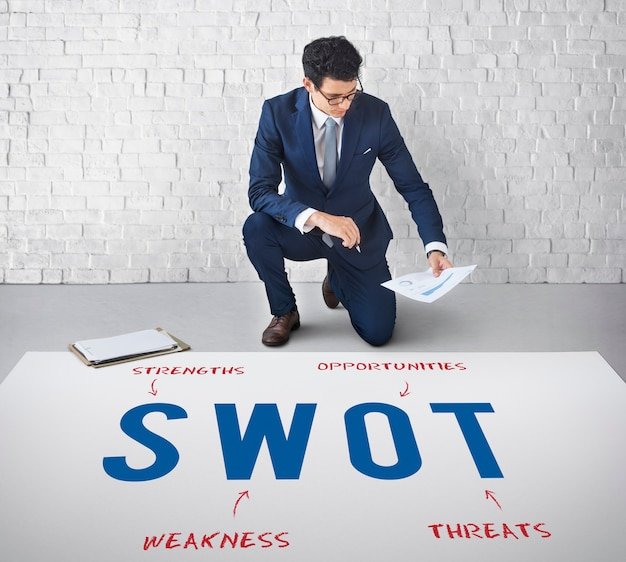Best Competitive Analysis Techniques for Your Business Success
-
Yuri Seleznev
Copywriter Elbuz
Imagine: your business is growing, competitors are closing in on your heels, and it seems that every step needs to be calculated with pinpoint precision. You know that success is impossible without understanding who is nearby in the market... How exactly will competitive analysis help you? Competitive analysis methods are like the keys that open all doors. Each of the methods that will be discussed later in this article works with a bang, opening up new horizons for business growth. And it is precisely thanks to such a detailed approach that your business will be able not only to maintain its position, but also to be significantly ahead of its competitors. Don't wait for your competitors to take the first step - quickly arm yourself with knowledge and act!

Glossary
- 📊 SWOT analysis: A method of analysis that includes the study of Strengths, Weaknesses, Opportunities and Threats of the business.
- ⚔️ Porter's Five Forces: A model for assessing the competitive environment, including an analysis of the impact of five key forces: threats of new entrants, threats substitutes, bargaining power of buyers, bargaining power of suppliers and competition among existing players.
- 🔍 Competitive Product Analysis: The process of studying competitors' products to determine their strengths, weaknesses, and opportunities for improving your own products or services.
- 📈 Competitive Environment: The overall context in which a business operates, including all external factors that affect competition.
- 🛠️ Competitive analysis tools: A set of methods and techniques used to collect and analyze information about competitors.
- 🌍 PEST analysis: Methodology for analyzing external factors affecting business, including political, economic (Economic), social (Social) and technological (Technological) factors.
- 🚀 SPACE Matrix: A strategic management tool that helps businesses determine their strategic position based on four factors: Financial strength (Financial Strength), Competitive Advantage, Environmental Stability and Industry Strength.
- 📄 Preparing for Competitive Analysis: The process of collecting the necessary information and data before starting the analysis, including the selection of methods and tools.
- 🔑 Business Strengths: Internal characteristics of the company that give it an advantage over its competitors.
- 🧩 Business Weaknesses: Internal characteristics of a company that put it at a disadvantage compared to its competitors.
- 🌱 Growth Opportunities: External factors or situations that a business can use to develop and expand.
- 🌩️ Threats to business: External factors or events that may negatively affect the company's activities.
It is important for business to know competitors: experience of successful analysis
Competitor research is a task that may seem time-consuming, but no successful business can do without it. One of the most useful methods is the analysis of competitive products. I always start with it when I take on a new project.

What is Competitive Product Analysis?
Competitive product analysis is the process of evaluating and comparing the products or services offered by your competitors. With its help, you can identify the advantages and disadvantages of your own product and understand what exactly attracts or repels customers. Now I will explain how I did this in practice.
How I conducted a competitive product analysis
I started by monitoring the main competitors in the market. Used various tools like SEMrush and SimilarWeb which helped me evaluate their website traffic, popular keywords and traffic sources.
Objectives and goals of analysis
- 🥇 Identify the strengths and weaknesses of competitive products.
- 🥈 Find opportunities to improve your product.
- 🥉 Develop a promotion strategy based on the results of the analysis.
Summary and results
Example from my experience: I worked with a company involved in the production environmentally friendly packaging. Competitors have already offered several similar products, but with certain disadvantages, such as high price and poor environmental friendliness.
- 🏷️ Competitors' products were priced 20% higher than ours.
- 🌱 The environmental friendliness of their packaging did not meet the stated standards.
Based on this data, I proposed to focus on the price attractiveness and true environmental friendliness of our products. I believe this approach has helped us stand out from our competitors and attract new audiences.

Important Aspects
During the analysis process, I also paid attention to customer reviews and social networks. Paying attention to positive and negative reviews to understand what exactly customers like or don’t like. In this way, we were able to identify the aspects that were most important to customers and improve our product.
What I recommend you do:
- 🔍 Explore competitor reviews on various platforms.
- 📊 Use analytical tools to compare.
- 📣 Consider customer opinions when developing your product.
Benefits of Competitive Product Analysis
I am convinced that competitive product analysis helps to determine not only strengths, but also weaknesses of your company. This allows you to develop a strategy that will help improve your position in the market.
🚀 Benefits:
- An opportunity to make your product more competitive.
- Understanding the needs of your target audience.
- See prospects for innovation.
📉 Disadvantages:
- Time and resource costs.
- The need to regularly update data.

Best Practices and Tips
I recommend regularly conducting competitor analysis to stay on top of market trends and respond to changes. Here are my best practices:
- Systematicity: I advise you to analyze at least one once a quarter.
- Multiple sources: Use multiple tools and platforms to get a complete picture of the market.
- Openness to change: I insist that you always be willing to change your strategy in response to new data .
| Helpful steps | Unhelpful actions |
|---|---|
| Research of competitive products | Ignoring customer opinions |
| Analyze reviews | Focus on one source |
| Use analytics | Lack of systematicity |
Summary
Competitive product analysis is a powerful tool that can help you improve your strategy and offer the market something better than your rivals. I am confident that by applying the methods described above and tips from my personal experience, you can significantly strengthen your company's position in the market.
How to prepare for a competitive analysis
When I For the first time I was faced with the need to conduct a competitive analysis, I realized that preparation was the key step. I first focused on gathering basic information about competitors, determining who they are, how they operate, and what strategies they use. The correct preparation stage ensured the success of the entire analysis.

Dividing competitors into types
I have found that dividing competitors into direct, indirect and non-obvious greatly simplifies the process:
- 🔍 Direct competitors usually operate in the same territory and sell similar products at similar price levels.
- 🎯 Indirect competitors work with the same target audience, but offer completely different products.
- 🚀 Non-obvious competitors are companies that were previously in a different field, but are now developing in a related direction.
Competitor Search Methods
I have tested various competitor search methods and found that they can vary depending on resources and research goals:
- 📊 Search results.
- 📧 Monitoring of targeted and contextual advertising.
- 🗣️ Discussions on forums and review sites.
- 📰 Official news publications and sources with statistical data that often publish ratings.
Example from my practice
On one of the projects, I worked with a team on analysis market for a startup. We used resources such as OLX and social networks to find unobvious competitors.
During the analysis process, we were able to identify some of the weaknesses of our startup and used this information to make strategic decisions:
- 🛠️ Improved product quality.
- 🌐 Strengthened our presence in the online environment.
- 📉 Reduced production costs.

Analytics and Recommendations
I sincerely advise entrepreneurs and analysts to use a similar approach to conduct competitive analysis. I would like to share the main findings that helped me:
“It all starts with thorough research and preparation.” - Sherlock Holmes.
Table: Best practices and mistakes in competitive analysis
| Best practices | Mistakes to Avoid |
|---|---|
| Clear definition of competitor types | Skip the competitor classification step |
| Constant monitoring of online activity of competitors | Ignoring news publications and statistical data |
| Assessing strengths and weaknesses | Lack of thorough competitive product analysis |
I am convinced that proper competitive analysis provides unique opportunities for business growth. Give due attention to preparation and research so that your business can have a significant market share and grow in the right direction.
Effective methods of competitive analysis
I want to share my experience in using various competitive analysis techniques, which helped me improve the position of my business in the market. In this chapter, I will talk about all of these methods, starting with the most popular - SWOT analysis, and continuing with Porter's five forces technique, PEST analysis and SPACE analysis. Perhaps my experience will help you better understand how competitive intelligence can serve your business interests.

SWOT analysis
SWOT analysis is an unrivaled tool for assessing the current state of a business and strategic planning. From personal experience I can say that its versatility and simplicity allow it to be used in any area of business. I've used this method multiple times with various companies, and it measures four key areas:
- 🟢 Strengths: What makes your product or service unique? I always look for unique offerings that make my business stand out from the competition.
- 🟠 Weaknesses: What internal factors limit growth opportunities? I often conduct internal audits to identify deficiencies and correct them immediately.
- 🌟 Opportunities: What external conditions can support growth? Market analysis and identification of new trends help to find opportunities to increase sales and expand the target audience.
- 🔴 Threats: What external factors can negatively affect the business? I recommend constantly monitoring legislative changes, economic conditions and the actions of competitors.
The advantage of SWOT analysis is that it allows you to see the real picture and work on improvement. Important: It can be somewhat subjective and therefore results may vary from person to person.
Porter's Five Forces Method
Porter's Five Forces Method has over the years gained a reputation as an indispensable tool for in-depth analysis of the competitive environment.

When developing my business strategy, I have always focused on the following forces that determine competitive position:
- Competition within the industry: Assessing key competitors and their strategies.
- Threat of Substitutes: The extent to which competitors can offer substitute products or services and reduce your attractiveness.
- Threat of New Entries: Barriers to entry for new players in your industry.
- Supplier Power: Dependence on key suppliers and their ability to influence prices and quality.
- Buyer Power: How sensitive are your customers to price changes and quality, what alternatives do they have.
Every time I turn to this method when planning a new marketing strategy or assessing possible risks. This approach helps me identify my weaknesses and opportunities to strengthen my position.
PEST analysis
PEST analysis allows me to evaluate a business from above, considering the influence of political, economic, social and technological factors. This technique helps me see the bigger picture and understand how external forces can affect my business.
- Political: For example, I always take into account possible changes in legislation and political trends.
- Economic: Factors such as inflation and exchange rates can greatly affect costs and pricing.
- Social: I am interested in changes in preferences and social trends, because this directly affects demand.
- Technological: The introduction of new technologies that can radically change the way goods and services are produced or distributed.

I found this method especially useful in understanding the macroeconomic situation and forecasting future changes.
Real example When I started a new project in developing country, a PEST analysis showed that the country was on the verge of choosing a new government, which could potentially change the entire economic climate. This helped me adjust my strategy and prepare for possible changes.
Rule of thumb: Always check current data and forecasts from reliable sources, as they can change at any time.
SPACE analysis
SPACE analysis (Strategic Position and Action Evaluation) I consider an important tool for assessing the strategic position of a company and planning further actions. I use it to evaluate:
- Financial position: Analysis of profit, profitability and accounts payable debt.
- Market Position: Assessing market share and competitiveness.
- Company potential: Taking into account resource intensity and growth opportunities.
- Industry stability: Analysis of external factors affecting industry stability.
This method helps me develop detailed reports and build strategic plans based on competitors' activities.
.png)
I sincerely hope that my experience and advice will help you meet the challenges of a competitive analysis and find new opportunities for growth in your business.
Briefly about the main thing
Superficial competitive analysis
It is recommended to conduct a superficial, shallow competitive analysis at least once every three months. It is important to look for such a short time in order to always be aware of current events in the market. When I started working with this methodology, I found that regularly checking the competitive environment allowed me to respond more quickly to changes and adapt my strategies. For example, one day, after analyzing the behavior of a competitor, I noticed that he had introduced a new discount campaign. In response to this, I also launched my own promotion, which allowed me to retain the client and increase profits.

Benefits of shallow analysis
For superficial analysis, I usually use simple methods such as monitoring competitors' social networks and analyzing reviews. This allows you to:
- 🧐 Quickly identify new trends in the market
- 📊 Evaluate current campaigns and their results
- 🔍 Determine which strategies work for competitors and which don’t
I I can confidently say that it is the timeliness of this information that helps to avoid major mistakes and waste less time catching up with competitors. For example, one day I noticed that our competitor suddenly began to pay a lot of attention to a certain product category. The quick response to this also allowed us to change our sales focus and avoid losing market share.
Disadvantages of Surface Analysis
However, it is important to note that Surface Analysis has its limitations:
- 🚫 Missing deeper strategic factors
- 🚫 Possibility of misinterpretation of data
- 🚫 Lack of information for long-term planning
I believe that for deep understanding you need to combine surface analysis with other more detailed methods.

Good Surface Analysis Practices
From my experience, I would recommend paying attention to the following steps:
🚀 Regular monitoring of competitors on social networks and through online reviews
🚀 Analysis of pricing policy and prompt response to changes
🚀 Closely monitor new products or services of competitors
Examples of successful application
I would recommend giving an example from our practice. When we saw that our main competitor suddenly started raising prices, we decided to keep our prices the same but added a new free service. This allowed us to attract a new customer segment and increase our market share by 10%.
Useful and unhelpful practices
I will list useful and unhelpful practices in tabular form:
| Useful practices | Unhelpful practices |
|---|---|
| Regular market monitoring | Ignoring new trends |
| Responding quickly to changes | Delay in decision making |
| Analysis of reviews and opinions | Missing Important Strategic Factors |
Superficial competitive analysis is a powerful tool that , when used correctly, can give your business undeniable advantages. I strongly recommend not to neglect this method and carry out analysis on a regular basis.

Experience Purina
Client Description and Their Business
Purina is a leading global pet food and nutrition company . The company's mission is to improve the health and well-being of pets by providing high-quality, nutritious products that meet all modern standards.

Defining main goals and objectives
Purina's goal is not only to increase market share, but also to strengthen strategic competitiveness through innovation and increased customer loyalty. Key objectives include:
- Increase brand awareness.
- Improving the quality of products.
- Expansion of the assortment.
- Optimizing marketing strategies for vacation markets.
Statement of the main problem
The main challenge for Purina is intense competition from major brands and new players in the pet food market. An in-depth analysis of the competitive environment is required to identify the strengths and weaknesses of the company and identify new opportunities for growth and development of.
Characteristics and interests of the target audience
Purina's target audience is pet owners who are puzzled by the health and nutrition of their pets. They are looking for high quality, nutritious and proven products:
- 🌟 Ages 25 to 45.
- 🌟 With average and high income.
- 🌟 They actively use the Internet and social networks to search for information.
- 🌟 They put quality and safety first.

Key points that may be of interest to potential clients
Product innovation and research contributions are key aspects that can attract the attention of new customers. Purina is also actively involved in non-profit activities supporting shelters and animal welfare organizations, which has a positive impact on the company's image among consumers.
Facts, figures and specific results of the project
🔥 Market share has grown by 15% over the past year.
🔥 The introduction of new product lines led to an increase in the customer base by 20%.
🔥 More than 50 influencers and bloggers are used in marketing campaigns.
🔥 customer return rate increased by 30% due to improved product quality.
| Analysis method | Application in the project | Result |
|---|---|---|
| SWOT analysis | Assessment of internal and external factors | Refining Strategies to Strengthen Positions |
| Porter's Five Forces | Analysis of competitors and market opportunities | Optimization of competitive strategies |
| PEST analysis | Evaluation of external factors (political, economic, social, technological) | Adjustment of marketing policy |
| SPACE analysis | Strategic planning and risk assessment | Reducing risks and strengthening corporate governance |
"Conducting a high-quality competitive analysis helped us not only maintain our position in the market, but also significantly outperform our closest competitors." - Purina Press Office
These analysis methods allowed Purina to identify key strengths , such as: high quality products, good reputation and the presence of innovative developments. The analysis also helped identify growth opportunities such as entering new markets and developing new products. Ultimately, a thorough approach to competitive analysis gave Purina a distinct advantage in the market.

Often FAQs on the topic: Best Competitive Analysis Methods for Your Business Success
Thank you for reading and progressive development 🧠
Now, thanks to the knowledge of SWOT analysis , Porter's five forces and competitive product analysis, you are ready to turn your business into a real professional in the market. Imagine yourself as a spy in a movie 🎥 - now you not only know your opponents by sight, but also know their weaknesses and opportunities for growth. Your business will become a success!
Be sure to leave a comment below - I'd love to hear your thoughts and stories!
Author: Yuri Seleznev, independent expert at "Elbuz"

- Glossary
- It is important for business to know competitors: experience of successful analysis
- How to prepare for a competitive analysis
- Effective methods of competitive analysis
- Briefly about the main thing
- Experience Purina
- Often FAQs on the topic: Best Competitive Analysis Methods for Your Business Success
- Thank you for reading and progressive development
Article Target
Train and enlighten entrepreneurs and business analysts on the importance and techniques of competitive analysis.
Target audience
entrepreneurs, business analysts, marketers, small and medium-sized business owners, company executives
Hashtags
Save a link to this article
Yuri Seleznev
Copywriter ElbuzI unravel the secrets of successful online store automation, plunging into the world of effective solutions and secrets of online business - welcome to my virtual labyrinth, where every line is the key to automated success!
Discussion of the topic – Best Competitive Analysis Techniques for Your Business Success
Describes the main methods of competitive analysis, including SWOT analysis, Porter's five forces method, and competitive product analysis. Informing how these methods will help a business identify its strengths and weaknesses and find opportunities for growth.
Latest comments
15 comments
Write a comment
Your email address will not be published. Required fields are checked *













Юрий Селезнёв
Competitive analysis techniques can really help a business greatly in assessing its position in the market. Has anyone already used SWOT analysis in their projects? 🧐
Emily
Yuri, I recently did a SWOT for our startup. It turned out that we have a lot of opportunities in the market! But it was also useful to identify weaknesses.
Lukas
SWOT is a classic! But has anyone tried Porter's Five Forces? How does it feel? 🤔
Rafael
I think SWOT and Porter's Five Forces complement each other very well. We used both methods to analyze the market in Barcelona. The results were impressive!
Anna
Lukash, I used Porter’s five forces to analyze competitors in IT. We analyzed in detail what threats can control this market. Exciting!
Henrik
Ha! These tests are a headache. Everything always changes so quickly that they are of no use. 😒
Sophie
Henrik, analysis helps you prepare better! Thanks to this, we avoided major failures.
Giulia
Each tool is useful in its own way. For example, analyzing competitive products helped us improve our application. Customers have noted the improvements.
Юрий Селезнёв
Yes, a combination of tests is an excellent approach. What other methods do you use to identify growth opportunities? 🚀
Mateusz
We also conduct customer surveys. Direct feedback often provides more insight than static analyses.
Olga
I will add to the SWOT that it is important to review it regularly. My agency does this once every six months to stay on its toes.
Jean
We also use PESTEL analysis to understand more global factors that may influence our strategy.
Юрий Селезнёв
Great points! For example, PESTEL can be a great complement to SWOT, taking into account macroeconomic factors. What other useful tools help you?
Clara
We often use the BCG matrix to evaluate our products. This helps determine which products require more attention and investment.
Alicia
I couldn't agree more with previous speakers: combining methods, rather than betting entirely on one, brings true results.